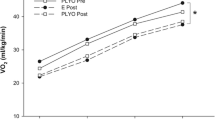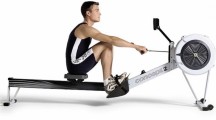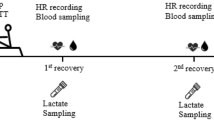Summary
The present experiment evaluated a new approach to establish exercise intensity during hydraulic rowing ergometry. In contrast to the traditional approach where exercise intensity is augmented by systematically increasing workload, the new procedure increments the intensity of exercise while maintaining a constant percentage of maximum force output. Ten college females exercised on a hydraulic rower that allowed for control of rowing speed and resistance. The new method to establish work intensity was to row at a cadence of 30 c·min−1 at a force output equal to 50% of maximum rowing force at each setting determined dynamically prior to testing. Two protocols were used for the maximum tests on the hydraulic rower. Row 1 was a 17-min, six-stage, incremental continuous row test performed at increasingly difficult settings from easy (setting 1; 603 N) to difficult (setting 6; 893 N). Row 2 was identical to row 1 until 15 min when resistance was reduced to setting 2 (658 N) for “allout” effort during the last 2 min. During this time, cadence declined from 30 c·min−1 to 19.4 c·min−1 at dial setting 6 and increased to 35.4 c·min−1 at dial setting 2. Both rowing protocols were compared to maximal physiological responses during treadmill running (TM). Compared to TM, both rowing protocols elicited. significantly lower maximum oxygen uptake (VO2max;P<0.05; row 1=Δ29.0% and row 2=Δ12.9%) and maximum heart rate (HRmax;P<0.05; row 1=Δ12.9% and row 2=Δ6.7%). Maximum ventilation (V Emax) during row 1 was also lower by 30.4% than TM (P<0.05). In addition, row 1 was significantly lower (P<0.05) than row 2 forVO2max (2.23 vs 2.60 l·min−1), HRmax (165.5 vs 177.3 beats·min−1), andV Emax (62.7 vs 86.3 1·min−1). These results demonstrate thatVO2max, HRmax, andV Emax are depressed when rowing exercise is performed at a high intensity relative to maximum strength. We conclude that the new approach to establish exercise intensity relative to maximum force production is more effective for eliciting near maximum values ofVO2, HR, andV E than the conventional method that increases the workload by set increments without consideration of maximal strength.
Similar content being viewed by others
References
Åstrand P-O, Rodahl K (1986) Textbook of work physiology. McGraw-Hill, New York
Bergh U, Kanstrup I-L, Ekblom B (1976) Maximal oxygen uptake during exercise with various combinations of arm and leg work. J Appl Physiol 41:191–196
Bouckaert J, Pannier JL, Vrijens J (1983) Cardiorespiratory response to bicycle and rowing ergometer exercise in oarsmen. Eur J Appl Physiol 51:51–59
Carey P, Stensland M, Hartley LH (1974) Comparison of oxygen uptake during maximal work on the treadmill and the rowing ergometer. Med Sci Sports 6:101–103
Cunningham DA, Goode PB, Critz JB (1975) Cardiorespiratory response to exercise on a rowing and bicycle ergometer. Med Sci Sports 7:37–43
Cureton KJ, Collins MA, Hill DW, McElhannon FM Jr (1988) Muscle hypertrophy in men and women. Med Sci Sports Exerc 20:338–344
Gleser MA, Horstman DH, Mello RP (1974) The effect of adding arm work to maximal leg work. Med Sci Sports 6:104–107
Hagerman FC, Lawerence RA, Mansfield MC (1988) A comparison of energy expenditure during rowing and cycling ergometry. Med Sci Sports Exerc 20:479–488
Hortobágy T, Katch FI, LaChance PF (1989) Interrelationships between various measures of upper body strength assessed by different contraction modes. Eur J Appl Physiol 58:749–755
Lagasse P-P, Katch FI, Katch VL, Roy M-A (1990) Reliability and validity of the omnitron resistance exercise and testing device. Int J Sports Med 11:455–459
Miles DS, Cox MH, Bomze JP (1989) Cardiovascular responses to upper body exercise in normals and cardiac patients. Med Sci Sports Exerc 21:5126–5131
Pendergast DR (1989) Cardiovascular, respiratory, and metabolic responses to upper body exercise. Med Sci Sports Exerc 21:S121-S125
Rosiello RA, Mahler DA, Ward JL (1987) Cardiovascular responses to rowing. Med Sci Sports Exerc 19:239–245
Sawka MN (1986) Physiology of upper body exercise. In: Pandolf K (ed) Exercise and sport sciences reviews, vol 14. Macmillan, New York pp 175–211
Shephard RJ (1984) Tests of maximum oxygen intake: a critical review. Sports Med 1:99–124
Shephard RJ, Bouhlel E, Vandewalle H, Monod H (1988) Muscle mass as a factor in limiting physical work. J Appl Physiol 64:1472–1479
Strømme SB, Ingjer F, Meen HD (1977) Assessment of maximal aerobic power in specifically trained athletes. J Appl Physiol 42:833–837
Author information
Authors and Affiliations
Rights and permissions
About this article
Cite this article
Jensen, R.L., Katch, F.I. A new approach to rowing ergometry: establishing exercise intensity relative to maximum force output. Europ. J. Appl. Physiol. 62, 44–48 (1991). https://doi.org/10.1007/BF00635633
Accepted:
Issue Date:
DOI: https://doi.org/10.1007/BF00635633




